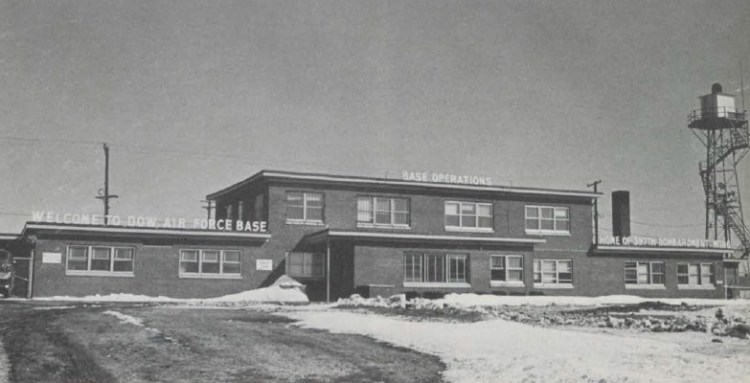April 1, 1968: Dow Air Force Base in Bangor officially closes. The city of Bangor obtains the airfield and reopens it the following year as Bangor International Airport.

Bangor had allocated $75,000 for development of the base in 1940. The Maine Military Defense Commission funded the purchase of the base’s land. With construction of what then was called Bangor Army Air Field 90 percent complete and U.S. participation in World War II looming, Army units began to occupy the base on April 19, 1941. (The U.S. Air Force became a separate branch of the military in 1947.) The first military plane, an A-17 attack aircraft, arrived in May.

The cover of A Guide to Dow AFB published in 1960 Courtesy of Bangor Community Digital Commons https://digicom.bpl.lib.me.us/books_pubs/187
The installation’s name was changed to Dow Air Field in 1942 to honor Army 2nd Lt. James Dow, an Oakfield native who died in a 1940 training accident in New York that killed 12 people.
Nearly 100,000 air combat crew members passed through Dow on their way to or returning from assignments during World War II. As the war wound down, the military considered closing the base as early as 1944, but instead made it an Air Transport Command cargo service site.
A new plan to close the base emerged in 1950. Bangor moved its airport from Old Town to the base that year. The military reactivated the site in 1951 as Dow Air Force Base, and the National Guard’s 132nd Fighter Wing moved in.
President Dwight Eisenhower visited the base on June 15, 1955, and gave a brief speech there, around the time construction of a base expansion took place.
To accommodate B-52 bombers, the longest runway east of the Mississippi River was built at Dow in 1958.
In 1964, the Air Force announced a plan to deactivate a Bomarc missile installation on the base, essentially meaning the base would close. The city began planning for the use of more than 100 buildings there. Easy access to Interstate 95 beginning in the mid-50s made locating a business there more appealing.
Today the Maine Air National Guard’s 101st Air Refueling Wing, which flies KC-135 tankers, is located at the airport.
April 1, 1980: The U.S. Census conducted on this date shows that Maine’s population exceeds 1 million for the first time.
The 1.12 million inhabitants recorded represent a 13.4 percent increase in population since 1970, a greater increase than in any other 10-year period since 1850.

Temporary workers collect data from census forms in Portland on April 1, 1980. Portland Press Herald photo courtesy Portland Public Library Special Collections and Archives
April 1, 1987: Two heavy rainstorms and a quickly melting snowpack cause a regional flood in northern New England.

Foot bridge connecting Topsham and Brunswick taken from Topsham side. River near crest at 9 a.m. Photo courtesy of the National Weather Service, Gray
The damage from the first storm, estimated at more than $74.5 million, is most severe in the Kennebec River Valley, where Winslow’s historic Fort Halifax blockhouse is washed down the river. A coal shed in Gardiner also floats away. Downtown Hallowell’s streets are underwater, and the river fills the first floors of buildings there. The water crests in Augusta at 17 feet above flood stage.
The Androscoggin, Penobscot and Saco rivers also flood badly. Gov. John McKernan signs a disaster declaration covering every Maine county except Aroostook and Washington. It is the most severe flood in the state’s history.
The second storm misses Maine but causes considerable damage in New Hampshire and Massachusetts.
The scattered parts of the blockhouse are retrieved, brought back to Winslow and reassembled, piece by piece.
Joseph Owen is a retired copy desk chief of the Morning Sentinel and Kennebec Journal and board member of the Kennebec Historical Society. He can be contacted at: jowen@mainetoday.com.
Send questions/comments to the editors.


